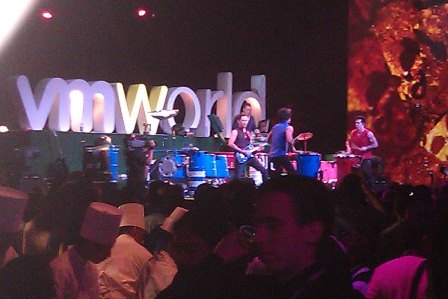Trip to the Desert to Ponder the Cloud - VMWorld 2011

I spent the better part of the week at VMWorld 2011 in Las Vegas, VMware’s annual conference dedicated to promoting cloud computing and the virtues of all things virtual. This year over 20,000 people attended. It was a first for me and for NDItech and I was fortunate to have the opportunity to share the stage with executives from Adobe, Oxford University and Concur travel to talk about NDItech’s pilot cloud project. We’re working with VMware and their hosting partner Bluelock to clone our commonly used web applications in the cloud (more details on this project in next week’s blog post).
I left the conference sufficiently awed and humbled after spending time with the amazing engineers and tech managers that are running some of the biggest and most complex data centers in the world - the virtual world, that is. The technical aspects of the transformation of our computing lives to the cloud are fascinating if not overwhelming and it was exciting to be reconnecting with my Silicon Valley roots and some old friends. I was also reminded of some of the fun that our Bay Area friends have at their conferences - including great parties and food, one featuring a private concert by The Killers (not pictured, that was the warm up band, Recycled Percussion).
I’ve summarized a few of the general take-aways from the conference below. I’m also working on a post that will address the larger question that we’re grappling with here at NDITech:
What does the transformation of IT to the cloud mean for democracy, democratic development and protecting human rights?
The short answer is “more than you might think.” I’m scratching the surface on that question after learning quite a bit this week, and working on a post for next week.
I was well aware of virtualization of servers and the ideas around building out public and private clouds. NDI has started our journey to the cloud (as VMware marketing folks like to call it) for our internal operations. However, VMware and other vendors have made amazing strides in the latest suite of VMware tools (VSphere 5.0 and related tools) in virtualizing everything in the data center - including data centers themselves! I learned a lot about virtual networks, virtual applications (including Windows-based apps), virtual desktops, mobile phones, even entire virtual data centers. Terms like elastic and fabric are commonplace now to describe extraordinarily malleable networks and server resources being shared across virtual applications running on an almost limitless number of virtual machines (VMs) or even super huge “monster VMs” - that can apparently scale to support the largest software applications in the world. A fantastic new set of cloud technologies and concepts that represent the next major shift in computing.
In their respective keynote addresses, VMware CEO Paul Maritz talked about a move away from desktops as the way IT teams need to think about the devices they provide to a new generation of devices including all types of mobile devices being accessed from anywhere. He also talked about a “post document era” being ushered in by younger generations in which we all have a new way of experiencing information, streams of data and collaborative information spaces - not documents!
CTO Stephen Harrod described the shift from the IT perspective as a move from thinking about individual servers and PCs, to services and people - “a fundamentally different way of thinking about IT”. The people we work with will expect ubiquitous access to all the services they require to get their work done from whatever device they want from wherever they want. His three main points construct the acronym DUH!: Devices (we’re going to have to support them all); Universal access from wherever everyone happens to be; and High expectations about getting the services they want with impeccable performance and reliability.
DUH!, or more like WHOA! This brave new world creates immense challenges for IT, and I believe, great opportunities for ICT and democracy. In many ways the performance, scalability and reliability issues that need to be addressed are not new and the concepts around deploying these solutions in the virtual world seem manageable. The virtual technology that has been developed to do so is amazing. I think this new world will be particularly challenging around security for IT going forward.
However, the benefits of virtualization, software as a service (SaaS), and other cloud technologies provide unique opportunities for those of us working in developing countries, emerging democracies and even some of the tougher environments like authoritarian states. Most of us are already using the cloud in various ways, from free webmail accounts to cheap web hosting environments. However, if we stop and think about it there are lots of other ways NDITech and everyone else working to help use technology to make the world a better place can use these new technologies.
My next couple posts will share my thinking on this, but I’m sure it will be an ongoing conversation.
